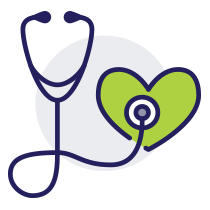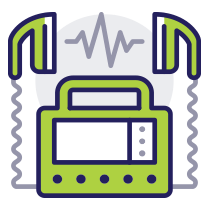If there were a symbol for each month of the year, the heart would be the symbol for February. Of course, this month sees the holiday of love, Valentine’s Day, but there’s another reason for hearts to have heavy significance this month as well…It’s American Heart Month!
What is American Heart Month?
American Heart Month was founded in 1963 in an effort to promote heart health and to educate Americans about heart disease (also known as cardiovascular disease). While deaths from heart disease have decreased since the first American Heart Month, heart disease continues to be a leading cause of death for both men and women. Each year, cardiovascular disease accounts for one in four deaths in the United States, many of which are very preventable. There are several types of heart conditions that fall under “heart disease,” the most common being coronary artery disease (CAD).
Why is heart health important?
The heart is an essential organ that pumps blood throughout your body, providing your body with the oxygen and nutrients it needs. There are two sides of the heart: the right side receives blood from your body and pumps it to your lungs, and the left side receives blood from your lungs and pumps it to the rest of your body. The blood vessels that carry blood away from your heart are called arteries while the blood vessels that carry blood to your heart are called veins. It takes less than 60 seconds for your heart to pump blood to the rest of your body. This steady circulation of blood throughout your body keeps you alive. When your heart suffers, your overall health suffers. It’s important to keep your heart healthy to protect yourself from serious illness and death.
Symptoms and Risk Factors of Heart Disease
Heart disease can go undetected until experiencing symptoms of events such as heart attack, arrhythmia, and heart failure.

Heart Attack
Heart attacks occur when your heart is unable to get enough blood. Symptoms of heart attack include: chest pain or discomfort (pressure, squeezing, fullness, or pain); feeling weak or light-headed; pain in the jaw, neck, or back; pain in one or both arms or shoulders; shortness of breath.

Arrhythmia
Heart arrhythmia is an irregular heartbeat, meaning your heart beats too slow or too fast. It is caused by problems with your body’s electrical system. When the electrical signals that coordinate your heartbeats don’t work properly, then your heart loses its natural rhythm.
Arrhythmias don’t always have noticeable symptoms, but it may feel like a fluttering in your chest and may cause shortness of breath and chest pain. Some other symptoms are anxiety, fatigue, dizziness, sweating, and fainting. It is common to have fast or slow heartbeats throughout the day, such as when exercising or sleeping, but when coupled with the other symptoms listed above, then it’s important to talk with your doctor.

Heart failure
Heart failure occurs when your heart is unable to pump enough blood and oxygen to the rest of your body. Some symptoms of heart failure include: shortness of breath during normal activities; trouble breathing while relaxing; weight gain and swelling in the feet, legs, ankles, or stomach; and feeling tired or weak.
The key risk factors for heart disease are high blood pressure, high blood cholesterol, and smoking; however, there are several other conditions and lifestyle choices that contribute to heart disease, including:
- Diabetes
- Obesity
- Poor diet
- Lack of exercise
- Excessive alcohol use
How to improve heart health: our top heart health tips
So, how can you improve your heart health to ensure you don’t experience any of the above symptoms and conditions? We’re glad you asked. Here are our 4 tips that you can do daily to improve your heart health:

- Eat a healthy diet
In this world of processed, fast foods, it’s easy to go for quick, tasty, and inexpensive food options. But it’s important to make sure that you eat foods that provide your body with the nutrients it needs to keep you healthy and energized. Here are some guidelines for creating a healthy diet:
- Focus on fruits, vegetables, and whole grains.
- Include a variety of proteins such as lean meats, poultry, seafood, eggs, beans, soy, nuts, and seeds.
- Eat foods that are low in saturated fats, trans fats, cholesterol, salt, and added sugars.
- Eat foods within your daily caloric needs. Use the USDA’s MyPlate Plan to help you determine your best calorie intake based on your age, sex, weight, height, and physical activity level.

- Stay active
Physical activity is important for overall health, but in today’s world of computers, internet, television, and video games, we have lots of excuses to not get adequate exercise. Here are some habits to adapt to ensure you fit necessary activity into your day:
- Work at a desk all day? Try taking a walk around the block during your lunch break every day. Or if your office has a stairwell, skip the elevator for a few floors.
- If you, like many Americans, have started working from home in recent years, try starting and ending your workday with a walk or bike ride around your neighborhood, taking the place of your daily commute to/from the office.
- If you live close enough to your workplace, try walking or riding a bike to work every day, assuming you can do so safely.
- Ask a friend to work out with you. Having a workout buddy can help to motivate you and keep you accountable.

- Manage stress
Stress can also have a negative impact on your heart health, as it often leads to behaviors that are bad for you. Some examples of poor health behaviors are smoking, excessive alcohol use, overeating, eating unhealthy foods, losing sleep, and lack of exercise. Here are some ways to manage your stress:
- Exercise regularly. Go for a walk or a run to release tension and anxiety.
- Practice mindfulness. Try meditation or yoga to connect with your body and release anxiety.
- Maintain social connections. Make time to have some fun with friends and family. And have meaningful conversations with people you trust.
- Create a relaxation routine. Take a bath, or drink some chamomile tea while reading a book or watching a show you enjoy. Let your mind and body relax from the day’s stressors.
- Find a hobby. Make time to focus on projects that you enjoy and that make you feel good.

- Avoid smoking
Smoking is the cause of many diseases, such as heart disease, stroke, cancer, lung disease, diabetes, and chronic obstructive pulmonary disease (COPD). According to the CDC, more than 16 million Americans are living with a disease caused by smoking. And it’s not only first-hand smoking that’s bad for your health. Secondhand smoke exposure kills approximately 41,000 non-smoking adults and 400 infants each year. If you’re a smoker, it’s important for your health that you quit as soon as possible. Your risk of disease will only increase if you don’t quit but will decrease over time once you do.
Final thoughts on heart health
We hope these tips will help you to live a healthier, happier, and longer life. And as always, if you ever find yourself in an emergency situation, whether related to heart health or not, your Best Neighbors Ever are always open and ready to get you on the path to recovery. Find your nearest location here.


Back to Blog